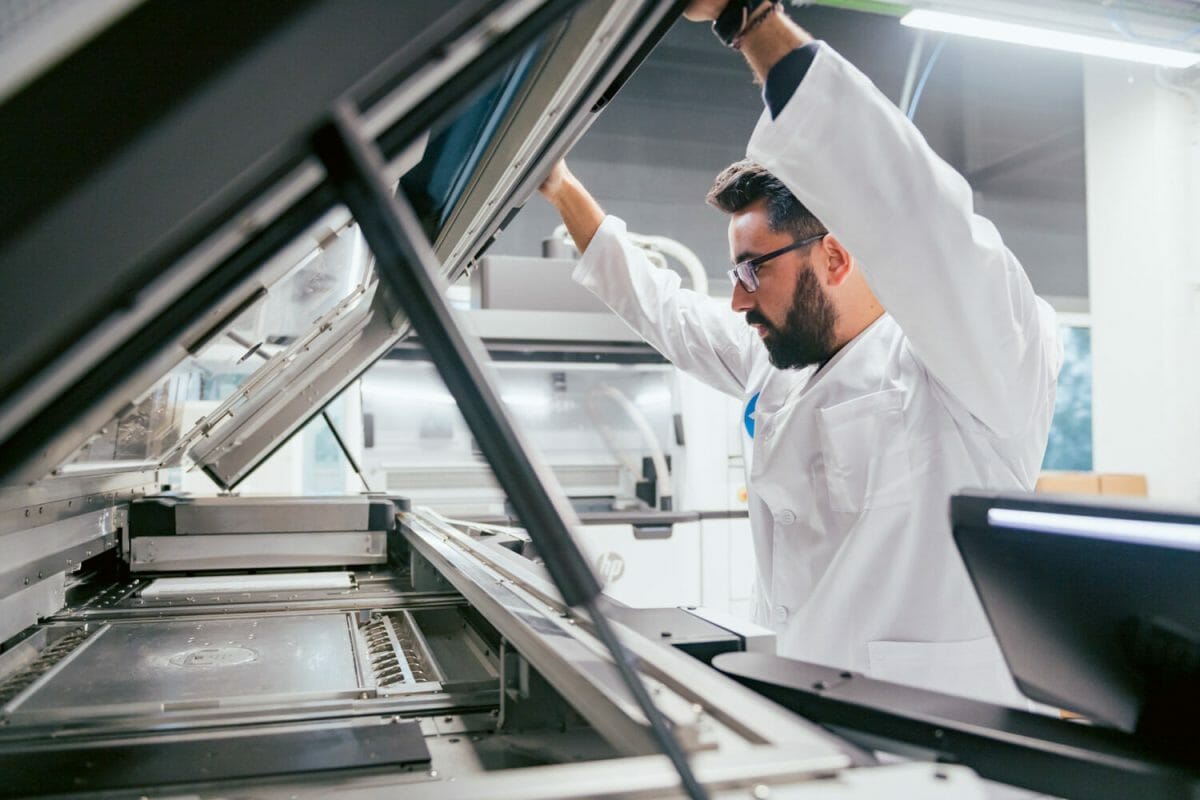Hospitals don’t talk much about it. Neither do doctors. And patients might worry if they knew.
But one of healthcare’s scarier little secrets is how extremely tricky it can be to accurately place screws into spinal pedicles during surgery. In fact, a few years ago five experienced surgeons were reportedly asked to manually insert hardware used to strengthen fused vertebrae into cadavers. When researchers reviewed a follow-up CT scan, they found placement error rates as high as 41%. Even worse, 21 of the screws surgeons implanted penetrated the medial wall of the pedicles and entered the vertebral canals.
It is difficult to know if such errors are generally that high in operating rooms. Study results vary. What is known, however, is that placing anything in the human body freehand can lead to serious consequences. And using pricey, complicated robotics systems, an increasingly popular alternative, is not for everyone.
That’s a reason why many doctors and hospitals are turning to 3D-printed surgical guides and other medical devices.
Moving beyond prototyping
Once considered a tool for prototyping and design, powerful industrial 3D printers now deliver quality, functional final parts and new levels of productivity that has changed the game, especially in healthcare. Indeed, from orthotics and prosthetics (O&P) to helmets for newborns and casts for broken bones, the ability to create one-of-a-kind products at scale with 3D printing — also known as mass personalization — is transforming healthcare to be more precise, relevant, and responsive to individual needs. Not surprisingly, this trend is boosting demand for 3D-printed gear with Acumen Research and Consulting Report predicting the 3D printing application market will hit $11 billion as soon as 2032.
What makes 3D printing attractive for healthcare isn’t just availability and price, though. It is the fact you can customize light-weight medical devices, such as surgical guides, for the specific anatomies of patients – with astounding precision. Mighty Oak Medical, for example, produced a surgical navigation solution that it says has tested at 99.7% for pedicle screw placement accuracy. The Englewood, Colorado med-tech company uses HP Jet Fusion printers to recreate a patient’s spine before surgery and 3D print disposable guides that surgeons use to drill, tap, and correctly position pedicle screws in vertebrae.
Navigation guides are just one example of how 3D printing is changing how we think about healthcare.
Transforming O&P
In O&P, for example, it would not be unreasonable to predict 90% to 100% of all artificial limbs, braces, and supports will one day be 3D printed. We are already seeing signs of that happening with a wide variety of novel approaches in universities, hospitals, and private companies. For example:
- The Royal Brisbane and Women’s Hospital (RBWH) in Australia, for instance, is trialing the production of 3D printed artificial eyeballs for patients who lost them through illness or injury.
- HP, meantime, is offering a complete, cloud-based system, the Arize Orthotics Solution, for 3D printing custom foot orthoses. With the solution, podiatrists and clinicians are able to scan the patient’s foot in less than five minutes, click a button, and have a precise, 3D printed insert or brace show up in less than two weeks. The entire process is completed faster than with traditional orthotic production methods. Accuracy and repeatability, meantime, are also significantly improved since clinician interpretation or guessing about design are eliminated. What’s more, doctors do not have to invest in a 3D printer to take advantage of the technology since all production is handled through the service’s central printing facility.
- Going smaller, medical researchers hope to create complex 3D replicas of human hearts, kidneys, tissues, and other organs through 3D bioprinting. It’s thought that as this technology matures, such materials could serve as valuable tools for studying diseases and testing how therapies in clinical trials might interact with the human body. At the same time, replicating body parts could reduce the need for organ donors, medical trial volunteers, and live-animal experiments.
By the way, 3D printed O&P products do not just aid human beings. Our furry friends benefit as well. In fact, late last year, a Krakow, Poland-based company called Wimba deployed an HP Multi Jet Fusion (MJF) 5210 machine to make prosthetics for dogs. 3D printed veterinary prosthetics have actually been around a while and are becoming more commonplace for birds, turtles, cats, horses, and a range of other pets.
Improving supply chains and sustainability
Aside from the specific devices and equipment they make possible, 3D printers also provide tremendous benefit to the medical industry from a supply chain standpoint. During the COVID-19 pandemic, when critical medical supplies like face masks and shields, swabs, and ventilator components were in short supply, locally or regionally based 3D printers were enlisted to quickly fill the gap and save lives. Since then, these machines have proven their worth for improving supply chain resiliency. By having 3D printers on site at hospitals, in research facilities, or at nearby print shops, healthcare organizations avoid having to wait for suppliers to ship vital medical gear cross-country or overseas.
Taking the 3D printing route also has the added advantage of being environmentally friendly. With 3D printing and digital manufacturing, digital files, as opposed to physical goods, are sent around the world. Parts and products are printed “just in time,” eliminating the need to stockpile items in physical warehouses. This means fewer trucks on the road, ships on the sea, and planes in the sky moving things about. It also means lower electricity use and carbon emissions since fewer power-hungry storage facilities are needed.
Getting started
So, how should healthcare organizations go about deciding whether 3D printing technology is right for them? It starts with evaluating your current situation. How much time are you wasting either waiting on devices and parts to be shipped or having them produced through traditional methods by a local manufacturer? How is the wait time impeding your ability to do your job? Do you have design freedom when trying to customize devices or are you restrained by legacy manufacturing approaches? And most importantly, how often are lesser quality medical products affecting the quality of care your doctors and nurses are able to deliver?
If it’s clear after asking yourself these questions that you have some issues, then 3D printers could be a viable solution. And in that case, you have a couple of options. First, you could reach out directly to 3D print experts at vendors like HP who are always standing by and ready to advise you. They might ultimately point you to a 3D managed printing service like Javelin Technologies or Materialise. Among other things, these services enable healthcare organizations to pay on an as-needed basis and get access to the latest and greatest 3D printing equipment, materials, and expertise without major up-front investment.
Although 3D printers have been around for decades, it is just now reaching the point where healthcare organizations can and should be considering their use for designing and delivering cutting-edge medical devices. With continual advances and emerging technologies like generative artificial intelligence (AI) coming along to provide smarter automated capabilities, these machines will only get better.
As such, organizations that embrace this technology will be in a better position to provide superior healthcare while radically improving operational efficiency. Those that lag, on the other hand, will surely struggle to deliver the kind of results their businesses and patients rightfully expect and deserve.

